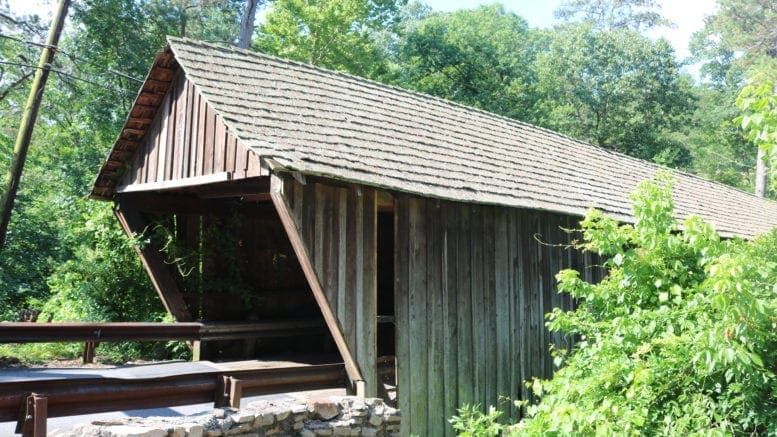During the 19th Century, wooden covered bridges were a common sight throughout the area that later became metro Atlanta. Before the 1920s, when creosote became the preferred way of protecting wooden bridges, and concrete and steel were gaining dominance as the materials for bridges, they were covered to protect the underlying structures from deterioration.
Concord Covered Bridge over Nickajack Creek was built in the mid-1800s, and after being damaged by fire during the Civil War was rebuilt in 1872.
Over the decades, particularly from the 1970s to the early 1990s, it was an open question whether the historic one-lane bridge would even survive.
The East-West Connector had been in planning since 1973 when the Atlanta Regional Commission put the highway on its list of proposed road projects. Austell, Mableton, and Powder Springs business owners had lobbied for a limited access road running from their areas to the interstate highways to the east.
There were two problems with the East-West Connector from the point of view of neighbors of the bridge, historic preservationists, and environmentalists. One was that it ran directly through wetlands, including areas around Nickajack Creek. The second was that several historic features, including the ruins of two 19th century mills, the rail line that later became the Silver Comet Trail, and the Concord Covered Bridge, were very near the proposed path.
The Cobb County Historic Preservation Commission was formed by long-time county commission Chairman Ernest Barrett near the end of his final term of office in 1984. Linda Cater, a preservationist from Vinings, had been, along with other county preservation activists, advocating for the commission. The formation of the commission made Cobb County the first county in Georgia to be eligible for federal preservation grants. Before the preservation commission was formed, only Georgia’s city governments were able to apply for those grants.
By the time the practical organization of the preservation commission was in progress in 1985, Earl Smith replaced Barrett as county commission chairman. The board for the new preservation commission was chosen by the Cobb County Board of Commissioners, with each commissioner choosing one preservation commission board member.
Immediately upon starting its work, the Cobb County Historic Preservation Commission came into conflict with the Cobb County Board of Commissioners. One of the preservation commission’s first acts was to propose the Concord Covered Bridge Historic District, directly in the path of Phase IV of the East-West Connector. Community opposition to the connector’s possible effects on the neighborhoods and the bridge encouraged the preservation commission to urge the county commission to put the path of the new highway as far from the covered bridge and other historic features as possible.
In 1986 the board of commissioners approved the Concord Covered Bridge Historic District but made it clear that the designation would not prevent the county from building the highway wherever it chose.
The East-West Connector was built, and the Concord Covered Bridge was preserved, but not without periodic conflicts and problems.
The June 21, 1995, edition of the Atlanta Constitution reported that Pat Seay of PEACH (Preserve Endangered Areas of Cobb’s History), told the paper her group was concerned that blasting for the East-West Connector would damage the bridge, and was seeking an injunction to have the path of the highway shifted away from the bridge.
Later, in 1989, the historic preservation commission became angry when the Cobb DOT chose a firm to conduct the archaeological survey of the site without consulting with the commission.
Recently the county used $800,000 in SPLOST funds to repair the bridge, which had started to lean. The bridge has been in a constant battle with the modern world of traffic and construction projects, and that battle is not likely to end soon.
[CORRECTION: An earlier version of this story used the possessive pronoun “his” in connection with Pat Seay, who is a woman]
References for this article:
Brasch, B. (2017, Jun 05). COBB COUNTY: Cobb approves $800K repair of Concord Road covered bridge: SPLOST to fund project to restore 145-year-old historic structure. The Atlanta Journal – Constitution
Nash, R. (1989, Mar 02). Awarding of contract draws fire. The Atlanta Constitution
Scott, Thomas. Cobb County, Georgia, and the Creation of the Suburban South.
For more information on the origins of the Cobb County historic preservation efforts, Thomas Scott’s book is probably the best starting point. The book is available via the link below:
